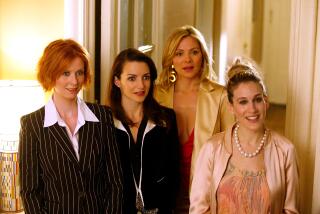Carrie Snodgress, 57; Best Actress Nominee
Carrie Snodgress, the actress who was nominated for a best actress Oscar for her performance in 1970’s “Diary of a Mad Housewife,” has died of heart failure. She was 57.
Snodgress was hospitalized at UCLA Medical Center awaiting a liver transplant when she died of heart failure on April 1, her manager, Sidney Craig, told the Associated Press on Friday. Her son, Zeke, by rock star Neil Young was at her side, he said.
A native of Barrington, Ill., Snodgress attended Northern Illinois University and began acting in Chicago, where she studied at the Goodman School of Drama. Among her early plays were “All the Way Home,” “Oh! What a Lovely War,” “Caesar and Cleopatra” and “Tartuffe,” for which she earned the Sarah Siddons Award.
Her success in Chicago brought her to Hollywood and a seven-year contract with Universal. She soon appeared in such 1960s TV series as “The Virginian” and “Judd for the Defense” and in the 1969 television movie “The Whole World Is Watching.”
But in 1970, after making her debut film “Rabbit, Run” opposite James Caan, Snodgress came to prominence in her role as a housewife driven to distraction and adultery in the comedy-drama “Diary of a Mad Housewife.”
Charles Champlin, former Times’ entertainment writer and critic, wrote of Snodgress: “The star system may be dead or dying ... but there is still no pleasure for the dedicated moviegoer quite like watching a vivid new personality light up the screen. It still happens, and it happens unforgettably in Frank and Eleanor Perry’s ‘Diary of a Mad Housewife.’ ”
Champlin described Snodgress as “a slight, young, hoarse-voiced and astonishingly lively and beautiful actress ... with that special combination of intensity, intelligence, feeling and sensuality.... Miss Snodgress is a genuine discovery.”
Snodgress’ “Housewife” role earned her an Academy Award nomination, two Golden Globes -- and a telephone message from an admiring Young, who said he wanted to meet her.
“I wasn’t a rock ‘n’ roll girl,” Snodgress told The Times in 1990. “I said, ‘Neil Young, Neil Young. Where do I know that name from?’ ”
Nevertheless, she said, she fell “madly and immediately” in love with Young and abandoned Hollywood, walking out on her contract to travel with the rocker and share his Northern California ranch.
In 1972, Snodgress gave birth to their son, who suffered partial paralysis and later cerebral palsy.
Snodgress did not return to acting until her relationship with Young ended.
In 1977, she appeared in a Detroit production of the play “Vanities” and then made Brian de Palma’s film “The Fury” with Kirk Douglas in 1978.
But the hiatus had hurt, and her career never moved back onto the fast track. Though she was rumored to abuse drugs and alcohol, she said she never took anything stronger than an aspirin.
“The industry wants you to be married to the industry,” she told The Times. “If you turn your back, if you go away once, then you’re subject to doing that again any time in your career.”
She was rarely seen in major films on the big screen, with notable exceptions for “Pale Rider” with Clint Eastwood in 1985 and as a vengeful murderess up against Charles Bronson’s cop in “Murphy’s Law” a year later.
But she found steady work on stage and television. Snodgress appeared in such plays as “The Manchurian Candidate” and in several television movies, among them “A Reason to Live,” “The Rose and the Jackal” and “Woman with a Past.”
She was familiar in such television series as “Quincy,” “Murder, She Wrote,” “In the Heat of the Night,” “The X-Files,” “Chicago Hope,” “ER,” “Touched by an Angel,” “Judging Amy” and “The West Wing.”
More recent television movies featuring Snodgress include “Rise and Walk: The Dennis Byrd Story” in 1994, her role as serial killer Ed Gein’s abusive mother in 2000’s “In the Light of the Moon” and in “Iron Jawed Angels” this year.
Although her renewed career never achieved the promise of her sparkling Hollywood beginning, she had no regrets.
“None,” she once told The Times. “I was never really a career woman, you see. My life always came first.”
After her relationship with Young ended, she married painter Robert Jones in 1981, but they separated within a few years.
There was a private funeral, and no public services were planned, Craig said.


